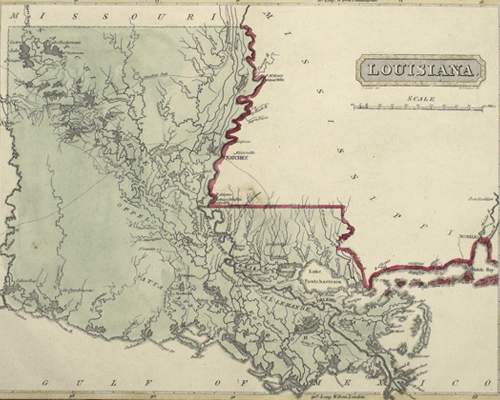2. Louisiana 1812 Alderman, New Orleans, District 3
3. Louisiana 1812 Alderman, New Orleans, District 4
4. Louisiana 1822 Alderman, New Orleans, District 1
5. Louisiana 1822 Alderman, New Orleans, District 2
6. Louisiana 1822 Alderman, New Orleans, District 3
7. Louisiana 1822 Alderman, New Orleans, District 4
8. Louisiana 1822 Alderman, New Orleans, District 5
9. Louisiana 1822 Alderman, New Orleans, District 6
10. Louisiana 1822 Alderman, New Orleans, District 7
11. Louisiana 1822 Alderman, New Orleans, District 8

The State of Louisiana, lying at the mouth of the Mississippi, was so named in honour of Louis XIV in 1682. Louisiana of the seventeenth century extended from the Mississippi River to the Rocky Mountains, and from the Rio Grande and Gulf of Mexico to BritishAmerica. The cession of Louisiana by France to the United States took place on 20 December, 1803, and in 1804, Congress organized the territory of Orléans, which comprised a portion of the great district of Louisiana. In 1806 there were but 350 English-speaking white men in New Orleans. Between 1806 and 1809, 3100 Americans arrived. In 1809-10 came the immigration from the West Indies, due to the Santo Domingo and Haitian negro uprisings. In 1810 the Irish began to come, and they kept coming steadily for over forty years.
In 1811 Congress authorized the inhabitants of the territory to draw up a constitution, with a view to establish a state government. The constitution was adopted in 1812, and immediately thereafter, on 30 April 1812, Congress admitted Louisiana to the Union. Almost simultaneously with her admission, the war with England broke out, and on 8 January 1815, the famous battle of New Orleans, between 12,000 English soldiers under Pakenham and 5000 American recruits under Andrew Jackson, was fought within a few miles of the city of New Orleans, resulting in the overwhelming defeat of the British.
Bibliography
Alderman
Alderman: Since the guilds became identified with the corporation or ruling municipal body: A magistrate in English and Irish cities and boroughs, next in dignity to the mayor; properly, as in London, the chief officer of a ward.
Oxford English Dictionary
1789 - 1825: A city position in Pensacola FL, Savannah GA, New Orleans LA, Annapolis MD, Boston MA, St. Louis MO, Albany NY, Hudson NY and New York NY.
Office Scope: City
Role Scope: City






